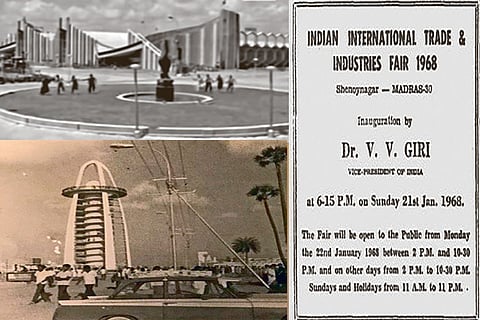

Chennai
Today, Anna Nagar is a prestigious habitation to live in Chennai. However, the event which brought Anna Nagar into focus and existence is sadly forgotten. For Madras with a century-long history of fairs, The Indian International Trade and Industries Fair of 1968 was the first industry-oriented one. Organised by the All India Manufacturers organisation to showcase Indian industrial development post-independence, it was planned to be the largest international trade fair in Asia.
The location identified was the Naduvinkarai village on the north banks of the Cooum. The fair was scheduled to open in 1967 but that being a watershed year in Madras politics the fair got postponed by a year till the new government got its bearings. The inaugural stage was simple and had a large picture of Bharat Ratna M Visvesvaraya, the founder of AIMO in the backdrop. Also, on stage were two men, who later became the presidents of India.
Vice president VV Giri pressed a button to light up a neon sign over the parabolic arch to inaugurate it. Despite the language tensions all over the south, anna maintained a straight face on stage. Little would he have known at that point of time that this entire place will become a posh neighbourhood named after him.
However, there was tough competition for the headlines and the fair was pushed to the background. Language riots were breaking out and the Madras troupe sent to participate in the New Delhi Republic Day parade had been assaulted and their tableaux damaged. Loud statements were being made by the DMK govt on its pet anti-Hindi theme. But the juicy news was the defamation case ongoing when former pals and ex-roommates Karunanidhi and Kannadasan met in the court. Karunanidhi had been accused by the poet of a misdemeanour in a helmet case for which the PWD minister sued him.
Eleven ministries, 23 public sector companies, many states and private sector industries participated other than foreign nations. The foreign participants were mainly the East European Communist bloc countries led by the U.S.S.R. People of Poland sent a gift of 15,000 pencils for the children to be distributed at the Polish pavilion. Though the consignment was held up in Customs, they were released on time and one given to every child who visited.
It took 15,000 workers to create the fair and a resident team of 2,000 were employed until it was over. Not worried about the impermanence of the fair, the organisers spent a lot of money — one view tower and seven concrete parabolic arches that made people wonder how they defied gravity without a pillar to support it in the middle. The 135-foot-tall phallic tower was named after the founder of the AIMO, Dr Visvesvaraya and was the undeniable embodiment of the fair. Designed by Yahya C Merchant, it was second in height only to the LIC building. More people came to see the view of the city from its top (at the cost of one Rupee) than to do real business. To those who climbed the tower, it created a feeling that the future Anna Nagar was not very far away from the mother city.
The designers had a field day creating the stalls. Air-India had a Mughal dome, Binny stall a pyramid, the fertiliser industry did a Hindu temple-like pavilion and Bata was like a zoo. Interesting exhibits too were displayed. The first elevator in the region was demonstrated to the visitors, tastefully spanning a pond. Canara Bank displayed currencies of over 50 countries. However, the biggest crowds stood before the display of Indian currency notes of 5,000 and 10,000, which many visitors had never seen before. The state trading corporation even showcased wigs made of hair donated by devotees to temples like Tirupathi. Madrasis saw television for the first time in a Japanese stall. Visitors could touch Gnat fighter planes as well.
The Railways had a mini-rail train network that puffed its way on round trips around their displays. Leyland transported visitors to the site in an open-top double-decker bus and another single-deck bus shaped like the houseboat of the Dal lake. Various entertainment programmes were also held. A Hema Malini dance and MS Viswanathan orchestra were ticketed and sold out. Traditional art forms of Tamil Nadu like poikal kuthirai and karagam were performed daily. Tamil film shootings were allowed and cinemas like Galatta Kalyanam remain documentary evidence of the fair.
Like the Eifel tower built in the Paris exposition, there were plans to remove the Visvesvaraya tower once the exhibition was over because it was standing in the middle of nowhere. But considering its popularity (the company which supplied cement used the structure in advertisements for half a century) as its predecessor, the government decided to let it stay. Likewise, Thailand and Kerala pavilions survived to serve as social clubs in Anna Nagar. In retrospect, students of urban studies would agree that if not for this fair, it is doubtful whether Anna Nagar would have taken shape at all in a couple of years.
(With inputs from Nam veedu, Nam oor, Nam kadhai, and architect Thirupurasundari)
— The writer is a historian and author
Visit news.dtnext.in to explore our interactive epaper!
Download the DT Next app for more exciting features!
Click here for iOS
Click here for Android